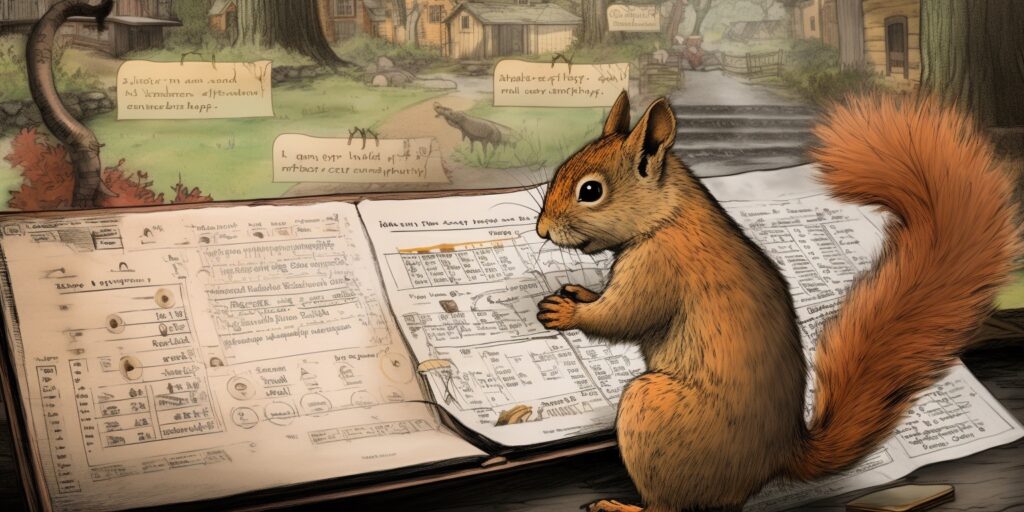A Cicada that waits 17 years underground to emerge; a Squirrel that can memorise the location of thousands of nuts by value. Meet nature’s low time preference specialists.

Planting a tree that you know you’ll never sit under. It’s one of the most powerful metaphors for the concept of low time preference – putting effort into an endeavour today that will only pay off further down the road. From Buffett to Einstein, there are plenty more famous quotes about delaying gratification, but surprisingly, Squirrels and Cicadas provide some of the most powerful illustrations of how time preference is really done.
Periodical Cicadas – Nature’s most patient
Perhaps the most powerful example of patience in the natural world is provided by the three species of Periodical Cicadas, which have the wonderful Latin name Magicicada.
Cicadas are a type of jumping insect best known for the loud and repetitive noise the pulsing of their drum-like exoskeletons produces. Cicadas provide the iconic summer soundtrack in their numerous native habitats across temperate regions.
The Magicicada, literally meaning magical cicadas, deserve their special title because they spend up to 17 years patiently waiting underground for the right soil conditions before emerging for a few brief weeks to feed and mate, then repeat the cycle.
What are Periodical Cicadas waiting for?
It’s a myth that Magicicadas hibernate for 17 years, like insect-Sleeping Beauties, snoozing until they’re ready to face the world. They are actually moving about down there, feeding off the sap from tree roots and biding their time, but what exactly are they waiting for?
The trigger point for these magical little drum machines to emerge is the right soil temperature above them – 18 degrees Celsius – to be exact.
Scientists aren’t sure how Periodical Cicadas know when their 17-year alarm call gets triggered but think they employ a molecular clock taking clues from seasonal changes in the trees communicated through the sap.
When they finally emerge into the sunlight, these yawning, wingless low time preference nymphs climb the nearest tree. There, they shed their skin and develop a tough outer shell in order to produce the right kind of beats to attract females.
Once impregnated, female Cicadas drill into the trees, generally hickory, oak, apple, peach, pear, and grape, to lay their eggs. The hatched larvae fall to the ground, then burrow down for their big sleep, with the process repeating in 17 years’ time.
The egg-laying process damages the branches to such an extent that if the lifecycle of Periodical Cicadas were shorter, the tree population would be decimated.
Equally, the number of sleeping beauties below soil sucking on the sap from roots could easily destroy the trees from below if they got greedy.
Instead, their metabolic rate drops enough that the loss is manageable, and everyone gets their fill of the good stuff. A perfect example of a circular economy.
The subtle variability of soil temperature geographically also means Periodical Cicadas’ emergence is staggered rather than in one massive plague; overall a better survival strategy for trees and bugs.
In 2024, two groups of periodical cicadas are expected to emerge in parallel for the first time since 1803.
The US states of Wisconsin and Illinois are likely to be carpeted with billions of these unique bugs and treated to their unmistakable clicking.
Squirrels – Nature’s Best Financial Planners
Squirrels, more than any other animal, demonstrate the quality of saving. Once you learn about the low time preference behaviour of this agile tree-hopping mammal, you’ll understand why they’ve earned their own verb ‘to squirrel away’, meaning ‘to put (something) in a safe or secret place, especially so that it can be kept for future use.’
Mikel Delgado, a professor of psychology, wrote a paper on the subject, ‘Cache decisions, competition, and cognition in the fox squirrel.’
Fox squirrels give a great demonstration of building a risk-adjusted portfolio. Nuts are their money, with the amount of time and energy spent stashing them underground based on relative calorific value (like a nut denomination) and scarcity.
Weighing up this nut asset value, Fox Squirrels will decide how far they can justify travelling to bury a nut and match cache density to value to minimise loss from rivals.
The Fox Squirrel can bury 10,000 nuts over Autumn – over 100 a day – and will remember the location of about 90% of the nuts in their diversified portfolio, which to them is a good risk-adjusted return.
To achieve this Herculean memory feat, the Fox Squirrel’s brain actually grows about 15% over Autumn, retaining this complex map of nutty treasure with 9,000 X’s in a mental treasure map.
‘Think of them as little bankers depositing money and spreading it out in different funds, and doing some management of those funds,’ Mikel Delgado, a professor in psychology. “They’re saving for the future, and they’re really smart about it.”
What humans can learn from Cicadas and Squirrels about time preference
Apart from providing some great little facts to impress friends, family and followers, what can we learn from the behaviour of Periodic Cicadas and Fox Squirrels?
First off, low time preference behaviour is a sensible survival and savings strategy. Bitcoin hodlers have certainly woken up to this idea.
The innate frequency of human existence seems to be speeding up, rather than slowing down. We want instant gratification, even though this seems to produce increasing ecological problems, summarised in the Tragedy of the Commons phenomenon.
Perhaps if we were as patient as Magicicada or as discerning and pragmatic as Fox Squirrels in how we invest our time and energy, we might all be richer for it in the long run, and the planet might not be in such a mess.
No Free Lunch
There is no such thing as a free lunch, but if you’re hungry to find out why, we’re here to help.
You can learn the meaning and origin of the no free lunch concept, as well as the broader philosophy behind the idea that nothing can ever be regarded as free.
We look at our relationship with money and truth, examining all of the supposed shortcuts, life hacks and get-rich-quick schemes.
